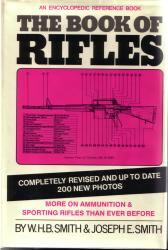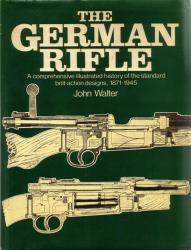|
The Swiss Vetterli Bolt Action Rifles |
|
|
|
|
|
CRUFFLER.COM
presents
HISTORIC
FIREARM OF THE MONTH,
July 2001:
|
The Swiss Vetterli Bolt Action Rifles |
|
|
M1878 Vetterli Rifle
Type: Bolt Action Infantry Rifle System of Operation: Manual Caliber: 10.4x38Rmm Rimfire Capacity: 12 round tube magazine Sights, front: Blade Sights, rear: Elevation Adjustable Notch Length: 52.2" l Weight (unloaded): 10.1 lbs Barrel: 33.1", 4 grooves, RH twist |
HISTORY
The Swiss
of the mid-nineteenth century viewed Prussia much in the same way that
the Western Europeans of the mid-twentieth viewed the Soviet Union.
Indeed, sharing a border with an undisputed military power with tremendous
resources at its disposal, coupled with an avowed thirst for power and
hunger for land was more than enough reason for the Swiss to pay attention
to developments in Berlin. They also paid attention to the terrible
effect with which the Prussians used their Dreyse Zunadelgewehre,
or "Needle Guns" against Schleswig-Holstein in 1849 and Austria in 1866.
The Needle Gun was the first breechloading rifle to be adopted by a major
military power. It used a special paper clad cartridge that contained
an ovoid lead ball that was inserted into a papier-mache sabot holding
a small pellet of fulminate of mercury in its base. When the Needle
Gun was fired, the needle is propelled through the base of the cartridge
(and the propellant) into the primer in the sabot. While not the
optimal system (the needles eroded so rapidly that each soldier was issued
with several spares), the effectiveness of the breech loading system could
not be denied. The Swiss, at any rate were not denying it.
Friedrich Vetterli joined the Weapons Department of Schweize Industrie-Gesellschaft (SIG) in 1864, and set to work on developing a metallic cartridge repeating rifle that would best the Needle Gun. The tactical paradigm that the Swiss operated on was wholly defensive, and was reflected in the design of Vetterli's rifle. A survey of world firearms technology at the time included the American Volcanic, Henry and Spencer repeating rifles, as well as the Needle Gun. All of these were analyzed with reference to the Swiss paradigm. The Henry was designed with hunting or mounted warfare in mind, hence the lever action. The Europeans, in awe of the Needle Gun, thought in terms of better needle guns. Vetterli, however, saw the merits of marrying the two into what would be effectively a bolt action repeater. Vetterli then proceeded to adapt the Henry to Swiss needs. The Henry's .44 caliber rimfire cartridge was refined into an improved .41
|
caliber
(10.4mm) design with a copper case. The King loading gate and Henry
cartridge lifter were adapted to a bolt action, which better suited the
Swiss defensive needs as it could be better fired from the prone position.
The bolt was an improvement of the Dreyse design. Instead of using
the bolt handle root's abutment against the receiver to lock, the Vetterli
bolt locks into the receiver with two lugs behind the cartridge elevator
well.
The Federal Assembly of the Swiss Confederation officially adopted the |
|
OPERATING
A VETTERLI
The Vetterli
is loaded by pressing cartridges nose first into the loading gate on the
right side of the receiver, and into the tubular magazine under the barrel.
The twelfth cartridge will lie on the cartridge elevator. When the
bolt is drawn vigorously to the rear, a projection on the lower part of
the bolt head engages the
|
|
Pressing the trigger fires the rifle. Rotating the bolt to the open position effects primary extraction, and as it is drawn to the rear, the expended case is withdrawn, to be ejected through the top of the receiver by the rising cartridge elevator.
THE RIFLES
MODEL 1867
TRIALS RIFLE
The first
Vetterli rifle to see service, the Model 1867 Trials Rifle had an external
ring hammer that was hung centrally, below the rear of the bolt.
The loading gate, positioned on the right side of the receiver had a pivoting
cover, and a the trigger guard had a distinctive spur. The rifle
used the rear sight of the Model 1863 musket, and accepted a Model 1863
socket bayonet.
MODEL 1869
RIFLE
Length: 51.95"
Weight: 10.27 lbs Barrel: 33.1," 4-groove, Right Hand
Twist
Sight graduated
to 1,000 Schritt (paces)
Muzzle Velocity
of 1,425 fps with M1867 Ball Cartridge
The Model
1869 Rifle was provisionally accepted for service on January 8th, 1869.
Initial production rifles had the cleaning rod mounted on the left side
of the stock. Field use revealed that the cleaning rods so mounted
were easily damaged, and a modification was approved on August 1st, 1869
moving the rod to a more conventional position beneath the barrel.
The modified M1869 was 51.2" long and weighed 10.16 lbs. It had a
tube magazine capable of holding eleven rounds, with twelfth round being
carried in the cartridge carrier, and a thirteenth in the chamber.
A knurled ring was added to the cocking piece to facilitate re-cocking
in case of a misfire. Additional modifications were made in 1870
that included the replacement of the rear stock retaining spring with a
transverse key that went through the forearm. In 1871 a new short
| rifle
was introduced, and the M1869 rifle incorporated the short rifle's mechanical
improvements starting in December 1871. These included an improved
cartridge elevator system and a simplified receiver that omitted the loading
gate cover. The rear sight was regraduated to 1,000m and weight rose
to 10.4 lbs.
A small number
of M1869 rifles were shortened in 1878 to account for shortages of M1871
carbines. Typically these were 37.2" long with a 19.1" barrel.
|
|
MODEL 1870
CADET RIFLE
Length: 45.25"
Weight: 7.16 lbs Barrel: 26.75," 4-groove, Right Hand
Twist
Sight graduated
to 600m
Muzzle Velocity
of 1,300 fps with M1867 Ball Cartridge
The single
shot Model 1870 Cadet Rifle was authorized for production by the Eidgenossische
Military Department on November 22nd, 1870. It was made exclusively
by SIG, and had a one piece stock reminiscent of the Italian Vetterli rifles.
Manufacture
History:
Schweizerische
Industrie-Gesellschaft, Neuhausen, 1870 - 1873
MODEL 1871
CARBINE
Length: 36.7"
Weight: 7.16 lbs Barrel: 18.5," 4-groove, Right Hand
Twist
Sight graduated
to 400m
Muzzle Velocity
of 1,230 fps with M1867 Ball Cartridge
The Model
1871 Carbine was adopted on February 20th, 1871, and had several unique
features. Among these were a rotating ejection port cover, a straight
edge forend and a "butter-knife" bolt handle. The original rear sight
was of the express type, with a standing notched block graduated for 225m
and folding leaves for 300m and 400m. On May 14th, 1872, a change
to the rear sight was adopted: The new rear sight was a sliding tangent
rear sight of the Thury type graduated from 225m to 400m. At approximately
the same time, the bolt handle was changed to a conventional grasping knob,
the forend acquired a noticeable step, and the receiver lost the leaf spring
on the left side. The rear sight was changed once again on November
4, 1874 to a Schmidt type that was fitted to the carbines as they were
returned to depots for repair. Production of the Model 1871 Carbine
concluded in August 1874.
Manufacture
History:
Eidgenossische
Montier-Werkstatte, Bern, 1871 - 1872, 500
Rudolf Pfenninger,
Stafa, 1872 - 1874, 2,500
Total Production:
3,000
MODEL 1871
SHORT RIFLE
Length: 49.6"
Weight: 10.2 lbs Barrel: 30.9," 4-groove, Right Hand
Twist
Sight graduated
to 1000m
Muzzle Velocity
of 1,375 fps with M1867 Ball Cartridge
The Model
1871 short rifle was intended as a supplemental arm to be issued to the
special Jager battalions. Adopted on February 27th, 1871, it was
slightly shorter than the standard infantry rifle, and sported a double
set trigger. The short rifle had only a single barrel band and a
heavier than normal buttplate.
Manufacture
History:
Schweitzerische
Industrie Gesellschaft, Neuhausen, 1871 - 1874, 1,000
Eidgenossische
Montier-Werkstatte and Eidgenossische Waffenfabrik, Bern, 1872 - 1879,
15,000
Total Production:
16,000
MODEL 1878
RIFLE
Length: 52.2"
Weight: 10.1 lbs Barrel: 33.1," 4-groove, Right Hand
Twist
Sight graduated
to 1200m
Muzzle Velocity
of 1,425 fps with M1867 Ball Cartridge
The Model
1878 rifle was the result of experiments that began in 1872 with the intent
of improving the Vetterli rifle. One of the experimental rifles had
a bolt guide above the wrist of the stock, while another had a double column
magazine containing more than 20 rounds (Editor's note: These
were banned in California, Maryland, New Jersey, and New York City as "Evil-Manually-Operated-Assault-Weapons.")
These experiments led to an improved infantry rifle that was adopted on
April 30th, 1878. While the action was
| almost
identical to that of the M1869 rifle, improvements had been made internally.
External differences included a single barrel band, the lack of diced checkering
on the forend, the mounting for a sword bayonet, and the fitting of a Schmidt
quadrant sight.
Manufacture History: Eidgenossische Waffenfabrik, Bern, 1878 - 1881, 100,000 Total Production: 100,000 |
|
MODEL 1878
BORDER GUARD CARBINE
Length: 37.2"
Weight: 7.36 lbs Barrel: 19.1," 4-groove, Right Hand
Twist
Sight graduated
to 600m
Muzzle Velocity
of 1,230 fps with M1867 Ball Cartridge
Very similar
to the M1878 carbine with an additional barrel band to carry the front
swivel and a rifle type nose cap that carried a bayonet lug for a sword
bayonet.
Manufacture
History:
Eidgenossische
Waffenfabrik, Bern, 1880 - 1881, 400
Total Production:
400
MODEL 1881
RIFLE
Length: 52"
Weight: 10.19 lbs Barrel: 33.05," 4-groove, Right Hand
Twist
Sight graduated
to 1,600m
Muzzle Velocity
of 1,425 fps with M1867 Ball Cartridge
The Model
1881 rifle was adopted on March 22nd, 1881 and featured the new Schmidt
quadrant sight with gradations from 225m to 1,200m and an extending sight
leaf for distances up to 1,600m. It also had the improved Schmidt
set trigger. Otherwise it was identical to the M1878 rifle.
Manufacture
History:
Eidgenossische
Waffenfabrik, Bern, 1881 - 1887
Total Production:
VETTERLI
DISASSEMBLY
The Vetterli
disassembles in a manner that is not readily intuitive to those weaned
on Mausers or Enfields; the bolt assembly is very different and the tube
magazine design requires a field stripping process that differs significantly
from later designs.
| With the bolt unlocked and partially to the rear, remove the slotted screw at the bottom rear of the left side of the receiver. This will free the cartridge lifter assembly for removal from the receiver. |
|
| Once the screw is removed, the cartridge lifter assembly can be eased out from the bottom of the receiver. The lifter assembly is a two piece unit that is held together only by the fit of the lifter arm into the elevator. |
|
| The lifter assembly can be easily separated into its two components by gently twisting them apart. |
|
| Once the lifter assembly is removed, use a slotted screwdriver to push the bolt retaining key as far to the left as it will go without forcing it (it's not supposed to come out the other side. |
|
| Once the bolt retaining key is fully to the left, the bolt can be witdrawn from the receiver. |
|
| The bolt can now be fully disassembled. Unscrew the large retaining ring at the rear of the bolt shroud. Be careful, as it is under spring pressure. Once off, remove the striker spring, bolt shroud body and striker. the bolt handle can now be removed from the bolt body, and the firing pin tipped out to the side of the bolt head. |
|
Reassembly is the reverse.
CONCLUSION
The Vetterli
was the most advanced rifle in service anywhere in the world when it was
adopted. Indeed, when the Swiss adopted the Vetterli, the American
army was still largely armed with muzzle loading rifle muskets, the British
were in the process of thinking about the Martini-Henry, and the Prussians
were still improving the twenty-five year old Needle Gun. More
than anything else, the Vetterli is a marvel of integration. Proven
technologies were analyzed and combined to create an advanced rifle that
met the unique tactical requirements of the Swiss strategic situation.
Perhaps the greatest testament to Vetterli's design was its use well into the twentieth century. Finnish revolutionaries in the early twentieth century purchased some 15,000 surplus Vetterlis from arms dealers in Paris and Hamburg. While the rifles were being offloaded, the ship, an old merchantman named the SS John Grafton, ran aground. Rather than lose the shipment to the Russians, the ship and remaining rifles were scuttled. Despite this precaution, the Russians recovered most of the rifles from the sunken ship and stored them in Czarist armories in Finland. The Finns smuggled additional Vetterlis into the country during the year following these events. These Vetterlis played a role in the Finnish War of Independence, and surfaced again during the Second World War. They were found in Finnish arsenals as late as the 1950's.
Like all Swiss
rifles, the Vetterlis demonstrate extremely high standards of manufacture
and great accuracy. The Vetterli stands alone among them though;
more than just a better implementation of ideas originated elsewhere, it
was a truly innovative design that was years ahead of its time.
BIBLIOGRAPHY
Ezell, Edward C., Small Arms of the World, 12th Edition, (Stackpole Books, Harrisburg, Pennsylvania: 1983)
Smith, W.H.B., and Joseph E. Smith, The Book of Rifles, (Castle Books, New York: 1972)
Walter, John, Rifles of the World, 2nd Edition, (Krause Publications, Iola, Wisconsin: 1998)
Walter, John, The German Rifle, (Arms and Armour Press, London: 1979)
Small Arms
of the World is available from IDSA Books. Click on the image
to order:

The Book
of Rifles is an out of print volume. You can search for it on
any of many out of print search engines on the 'Net.

The German
Rifle is available from IDSA Books. Click on the image to order:

Rifles of
the World is available from IDSA Books. Click on the image to
order:
